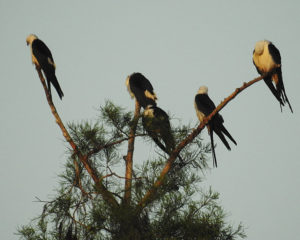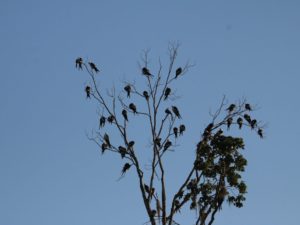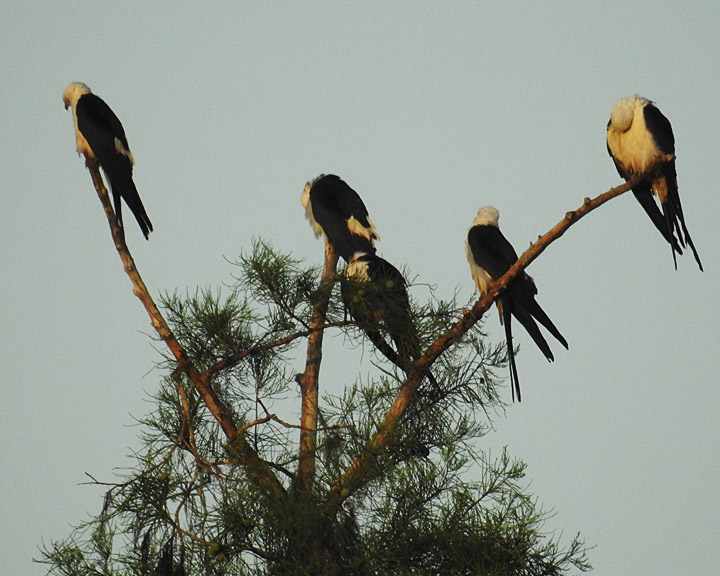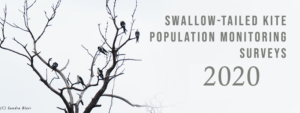 |
| @ D. Brewer 2018. Swallow-tailed Kites in roost tree. |
Every year since 1989, ARCI has conducted systematic aerial surveys to count Swallow-tailed Kites at more than 15 large pre-migration roosts during a 10-day window in late July. These roosts, some of which hold up to 4,000 birds, provide an extremely rare and valuable opportunity for long-term population monitoring of this imperiled species. This year, however, health, safety and funding constraints resulting from COVID-19 have forced us to scale back ARCI’s monitoring surveys by limiting our coverage to just the four largest roosts (which usually account for at least 85-90% of the birds observed) and by conducting fewer flights by focusing more tightly around the likely peak time period.
As a result, it will be particularly valuable this year to have YOU and YOUR KITE SIGHTINGS serving as our eyes on feeding and gathering places that we could not otherwise monitor and include in ARCI’s surveys.
Pre-migration roosts are places where Swallow-tailed Kites gather for the night after their nesting responsibilities are over, but prior to departure on their southbound migration. These night roosts also serve as jumping-off points for daily foraging flights, for which Swallow-tailed Kites usually travel in small flocks. In these ways, individual kites benefit by having a safe place to sleep (more eyes and ears to detect predators) and also from what they can learn from each other about good foraging opportunities over the surrounding landscape, which may shift in location over periods of days and even hours. Knowing the most productive places to feed allows the kites to gain weight rapidly and prepare themselves for their imminent 5,000+ mile southbound migration, which begins with a very dangerous 450 to 600-mile flight over open ocean to Mexico’s Yucatan Peninsula.
From years of conducting these carefully designed aerial photo surveys, we are confident that we are probably counting most of the Swallow-tailed Kites that nest and hatch in Florida each breeding season, and at least two-thirds of the individuals associated with nests across the seven southeastern states that represent the current United States breeding range of this species.
However, we know that we are missing kites that are NOT using these large roosts as pre-migration staging areas. This is why it is so useful to have your help in counting Swallow-tailed Kites during the same time period when we are conducting our systematic aerial surveys.
 |
| @ Beckner 2019. Swallow-tailed Kites in roost tree. |
How would you go about this? First and foremost, it is important that you protect your health and that of others by keeping your distance and wearing a mask when near others. Some of you may be able to see kites right in your neighborhood. Others may know of or suspect good observation conditions in secluded places within driving or paddling range, where you can search for roosting and foraging kites while maintaining safe distances from other people.
Besides considering the health of those around you, please be extremely careful not to disturb or flush any roosting kites. Even one such intrusion might discourage individual kites from returning to a well-known and favored roost sight where they can sleep safely and, in effect, share information about productive feeding areas, which are critically important to their health and safety during the long over-water first leg of their arduous southbound journey. If any kites suddenly rise up in energetic flight, or even if they just call at you or seem to continually look alert in your direction, please assume you are too close and back off immediately.
To contribute to our growing community database of Swallow-tailed Kite sightings during this very special time of year – and under these challenging current conditions – please report the date, time, location, number, and behavior of kites you see with this 2020 Population Monitoring Survey form. The form is responsive to your smart device, so you can even report from the field!
We are very grateful for your valuable help monitoring Swallow-tailed Kite population trends!
-The ARCI Team



Leave a Reply